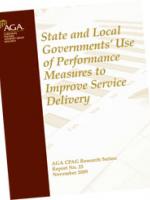
Using Performance Measures

The federal government’s chief performance officer, Jeff Zients, declared at a recent Senate hearing: “The test of a performance management system is whether it is used.” He thought federal agencies were failing the test.
So what should agencies do? Well, last week, the Association of Government Accountants (AGA) released a research report last week that offers practical and concrete advice based on a recent study,“State and Local Governments’ Use of Performance Measures to Improve Service Delivery.” According to AGA's Hal Steinberg who led this effort, “This project was intended to determine how performance measures are used by governments to improve service delivery and also to describe their efforts in such a way that other governments can adopt similar practices.”
The study identified the key elements of performance management that contributed to service improvements. It validated these elements via a series of case studies of four local governments (Baltimore, MD; Fishers, IN; New York City, NY; Westminster, CO) and Washington state government, as well as a broader survey of 175 other localities.
Key Findings. Not surprisingly, the study concluded “. . . success appears to depend on the commitment and involvement of a chief executive who sees the process as a tool for improved performance, and not just a compliance activity.”
Other key success factors included:
- the use of consistent measures from period to period to sustain attention on the measures, at the same time recognizing that measures can and should be modified when necessary to reflect changing requirements or expectations of stakeholders
- regular and frequent analysis of the performance results data in comparison to prior periods, targets or benchmarks.
- regular reviews of the analysis and results by the chief executive and/or his designee with the responsible agency heads, and
- agreements with the agency heads on steps to be taken when the data reveal the need and opportunities for improvement.
Essential Elements. The research identified via the case studies several essential elements that must be present in a governmental system before it is likely to use performance measures to improve service delivery. These were validated via the broader survey:
- chief executive commitment and involvement in the overall process
- relevant measures of at least outputs and eventually outcomes
- periodic review and revision of the performance measures
- frequent, regular collection of performance data
- comparison of performance data to prior periods
- regular review and analysis of performance results to ascertain the reasons for less-than-desirable performance and identify the opportunities for improvement
- chief executive and other senior management participation in the reviews
- agreement between chief executive and department managers on improvement plans
- follow up on progress (or lack thereof) of improvement plans
Supporting Elements. In addition to the essential elements, the study also identifies several elements that survey respondents thought were important practices:
- explicit targets for the performance measures
- frequent comparisons of performance data to targets
- comparison of performance data to the corresponding data from similar jurisdictions
- intragovernmental comparisons (in states and larger jurisdictions)
- support staff involvement in the reviews of performance results
- budget reviews and deliberations considering the performance targets and results
- budget resources allocated to programs rather than solely to object classes
- programs for obtaining and considering constituents’ views
- some process for assuring the data’s reliability
- regular external dissemination of performance results
AGA concludes: “This report demonstrates that the use of performance measures has already been adopted by many governments. It also provides guidance with which other governments can start to follow suit. The most significant missing piece is the desire and discipline to start and maintain the process-and that is ultimately up to each government body.”



